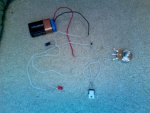- Joined
- Dec 8, 2008
- Messages
- 196
- Points
- 18
Ok this is the first DDL driver that I am building but in the second post by DDL that has the picture of the circuit in a breadboard the LM317T looks like the pins are reversed to me I understand the pin out is like this from right to left
1.IN
2.OUT
3.ADJUST
but in the picture it looks like the + from the battery is going to the adjust pin and it looks like you just put the LM317T in backwards. Please clarify what the right pin out is and if the picture is correct.
Also in Rog's picture that he posted on the first page he connects the 3 and 2 pins on the pot but in DDL's picture he connects the 1 and 2 pins can you do either?
On a pot you have 3 pins what is how do you know which one is 1, 2, and 3 and how do you measure the ohms on a pot what pins do you use?
Sorry for all the noob questions but I want to get this right and not fry anything lol
Any help is appreciated
Justin
1.IN
2.OUT
3.ADJUST
but in the picture it looks like the + from the battery is going to the adjust pin and it looks like you just put the LM317T in backwards. Please clarify what the right pin out is and if the picture is correct.
Also in Rog's picture that he posted on the first page he connects the 3 and 2 pins on the pot but in DDL's picture he connects the 1 and 2 pins can you do either?
On a pot you have 3 pins what is how do you know which one is 1, 2, and 3 and how do you measure the ohms on a pot what pins do you use?
Sorry for all the noob questions but I want to get this right and not fry anything lol
Any help is appreciated
Justin





